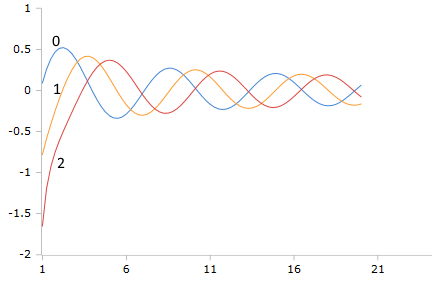Bessel-Y function for complex numbers
Calculator for the Bessel function Yv (z) of the second kind
The function Bessel-Y calculates the Bessel function Yv (z) of the second kind. The Bessel-Y functions show an oscillating (not an exponential) behavior. Bessel-Y (n, z) is a solution of the Bessel differential equation.
This function expects a complex number as argument \(z\).
Bessel functions for real numbers can be found here.
To perform the calculation, enter the complex number and the order number. Then click on the 'Calculate' button.
|

Plot of the Bessely function with ordinal numbers 0, 1 and 2
More complex functions
Absolute value (abs) • Angle • Conjugate • Division • Exponent • Logarithm to base 10 • Multiplication • Natural logarithm • Polarform • Power • Root • Reciprocal • Square root •Cosh • Sinh • Tanh •
Acos • Asin • Atan • Cos • Sin • Tan •
Airy function • Derivative Airy function •
Bessel-I • Bessel-Ie • Bessel-J • Bessel-Je • Bessel-K • Bessel-Ke • Bessel-Y • Bessel-Ye •
Description of the Bessel functions
The Bessel functions are a group of special mathematical functions, which occur in various physical and mathematical applications. They were originally defined by the mathematician Daniel Bernoulli and later generalized by Friedrich Bessel. These functions are solutions of the Bessel equation for an arbitrary complex parameter \( \alpha \), which represents the order of the Bessel function.
There are two main classes of Bessel functions:
-
Bessel function of the first kind (Jα): These functions are solutions of the Bessel differential equation,
which are not singular at the origin.
They are sometimes also referred to as cylinder functions or cylinder oscillations.
- Bessel function of the second kind (Yα): In contrast to the usual Bessel functions, which oscillate as functions of a real argument, the functions \(I_\alpha\) grow exponentially, while the functions \(K_\alpha\) decay exponentially. Like the ordinary Bessel function \(J_\alpha\), the function \(I_\alpha\) approaches zero for \(x = 0\), if \( \alpha > 0 \), and is finite for \(x = 0\) if \( \alpha = 0 \).
These functions play an important role in describing vibrations of a circular membrane, electromagnetic waves in cylindrical waveguides, heat conduction in cylindrical objects, acoustic membranes (such as drums) and much more. They are an indispensable tool for many problems of wave propagation and static potentials in the Physics and Engineering.
Definition of the Bessel functions
Bessel functions of the first genus (Jν)
The Bessel function of the first genus of the nth order is defined as:
\(\displaystyle J_{\nu}(z) = \sum_{m=0}^{\infty} \frac{(-1)^m}{m! \Gamma(m + \nu + 1)} \left(\frac{z}{2}\right)^{2m + \nu} \)
Here \( \Gamma \) is the gamma function.
At the origin (\( z = 0 \)) these functions are finite for integer values of \( \nu \).
For non-integer values of \( \nu \) there are two linearly independent solutions.
For integer values of \( \nu \) the relationship holds:
\(\displaystyle J_{-\nu}(z) = (-1)^{\nu} J_{\nu}(z) \)
Bessel functions of the second genus (Yν)
The Bessel function of second genus nth order is defined as:
\(\displaystyle Y_{\nu}(z) = \frac{J_{\nu}(z) \cos(\nu \pi) - J_{-\nu}(z)}{\sin(\nu \ pi)} \)
Modified Bessel functions (Iν, Kν)
The modified Bessel function of the first kind of nth order is defined as:
\(\displaystyle I_{\nu}(z) = i^{-\nu} J_{\nu}(iz) \)
The modified Bessel function of the second type nth order is defined as:
\(\displaystyle K_{\nu}(z) = \frac{\pi}{2} \frac{I_{-\nu}(z) - I_{\nu}(z)}{\sin(\nu \pi)} \)
|
|